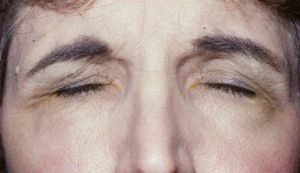 Anthony Hopkins in response to the question: how many times you blinked in the sequel to the movie "The Silence of the Lambs" exclaimed excitedly: never!
Anthony Hopkins in response to the question: how many times you blinked in the sequel to the movie "The Silence of the Lambs" exclaimed excitedly: never!
"Stopped", "glass", hypnotic, "snake", unblinking look of its exquisite screen villain can not be called pleasant.
But no less unpleasant and looking like a mockery of its opposite - which suddenly began in the midst of intense discussion, a frequent "wink" of one interlocutor to another.
"Winking", not corresponding neither to the situation, nor to the subject of conversation, which causes acute perplexity and just indignation of the second participant of the conversation. How many millions of transactions broke down because of such "familiarity", which is by no means accepted in the business world!
But the fact of the matter is that the coquettish podmargivaniem here does not even smell.
This is a medical case with a neurological bias - uncontrolled, arising for no apparent reason convulsive contraction of the circular eye muscle( knowing the closing of the eyelids), which can not be stopped by effort of will. Name this case: blepharospasm.
Morganje - the "mirror of the soul"?
With the fact that the eyes are a "mirror of the soul," it's hard not to agree. Here the child, standing "during interrogation" in front of the parent and looking directly at him at the  face, suddenly starts to "clap his eyelashes".
face, suddenly starts to "clap his eyelashes".
Does this mean that something has got into his eyes and something needs to be removed from there, with frequent blinking, causing a strong discharge of tear fluid that would wash and disinfect the surface of the eyes? No, he's just guilty and openly lies for his own salvation at any cost.
This simple test shows a deep connection between the state of the organ of vision - its sickness or health - and the state of the brain. Or not so large, but no less important, its nerve structures, in the depths of which the roots of pathology often lie:
- of the nuclei of the facial nerves;
- of the brainstem;
- basal ganglia.
And depending on the height of the location of the affected structures, the forms of manifestation of blepharospasm, and the degree of their severity, will be different.
From the episode to the
system The spectrum of manifestations of blepharospasm is unusually wide: from simple blinking to episodes of short-term rhythmic screwing up, from frequent spasms of the closing eyelids of the muscles( with separate rhythmic twitchings) - until the eyes are completely closed with the lowering of the eyelids and their inability to rise independently.

Clonic blepharospasm in the form of uncontrollable rapid blinking is characterized by:
- manifestation at a young age;
- as an occurrence without apparent causes, and the termination of the seizure itself;
- the initial one-sided manifestation( or alternately involving one or the other eye) with a gradual transition of the process to the neuromuscular apparatus of the second eye.
In the hysterical version of clonic blepharospasm( in young females) the process is initially bilateral, stops after several hours( days), either spontaneously or by pressing on the "clamped points" accidentally detected( points of exit from the skull of the branches of the trigeminal nerve).
To a tonic blepharospasm, expressed by an involuntary frequent and intense squinting, the patient comes in 2-3 years after the "debut" of the disease, when a gradual, but constant increase in the duration and force of spasms creates difficulties almost insurmountable in his life.
Inability to visually "read" the life situation( blindness with fully preserved vision) with a severe degree of disruption leads to a feeling of self-defective and to an even greater oppression of the patient's psyche with the aggravation of the disease to the degree of dystonia spreading first to the muscles of the mouth, and then to all the facialmuscle.
There are also blepharospasm:
- primary, or essential,
- secondary, or symptomatic.
 Unlike the speaker, as a separate syndrome of primary blepharospasm, "tied" usually to the age of over 40 years and to the associated degeneration of the neuromuscular "equipment" of the eyelids( but more often due to the pathology of cortical and subcortical nerve structures) and affecting women 3 timesmore often than men, secondary is a consequence of diseases of the body's vascular and inflammatory nature or trauma to the organs of the nervous system, or, often combined with oculogic crises, arises from the use of medicinal preparationsatov( neuroleptic blepharospasm, rapidly passing the termination receiving neuroleptic) and intoxications different kind( Poisoning furnace or carbon monoxide, gas).
Unlike the speaker, as a separate syndrome of primary blepharospasm, "tied" usually to the age of over 40 years and to the associated degeneration of the neuromuscular "equipment" of the eyelids( but more often due to the pathology of cortical and subcortical nerve structures) and affecting women 3 timesmore often than men, secondary is a consequence of diseases of the body's vascular and inflammatory nature or trauma to the organs of the nervous system, or, often combined with oculogic crises, arises from the use of medicinal preparationsatov( neuroleptic blepharospasm, rapidly passing the termination receiving neuroleptic) and intoxications different kind( Poisoning furnace or carbon monoxide, gas).
Reflex blepharospasm is caused by diseases like the eye and eyelids, as well as chronic processes in the cavities of the mouth, nasopharynx, and accessory sinuses.
Blepharospasm may be a symptom of Wilson's disease, Huntington's disease, Parkinson's disease, tetany, chorea, cortical epilepsy.
Methods and criteria for diagnosis
The recognition of the disorder and its differentiation from a similar pathology is greatly facilitated by the use in the work of Harrison's criteria - a complex analysis of factors that confirm or disprove the presence of this pathology.
These include:
- elucidation of certain moments of obstetric history of and development of the patient in childhood;
- careful exclusion of other symptoms of ( ataxia, paresis, convulsive seizures or similar neurological manifestations);
- check for the presence of dystonia musculature and dystonic postures;
- laboratory and instrumental diagnostics ( excluding changes in the fundus, demonstrating the norm in EEG, MRI and CT of the brain);
- elucidation of the possible precedent use of antipsychotics and other drugs provoking the appearance of the disease.
In order to limit the search area, defeat zones are resorted to using positron emission tomography( PET), to determine the  level of regional metabolism, proton MR spectroscopy is used.
level of regional metabolism, proton MR spectroscopy is used.
When comparing hysterical blepharospasm with another clonic idiopathic( essential, primary) form in favor of the first,
- will be indicated by convulsive contractions limited exclusively by the circular muscle of the eye, without involving the muscles of the forehead and lower half of the face;
- lack of self-help using corrective gestures( such as raising eyebrows, wrinkling your forehead, tilting your head back);
- is an obvious link of the syndrome with a neurotic background( with fanciful mannerisms, exaggerated poses and movements, with a sharp emphasis on hyperkinesis);
- the effectiveness of psychotherapy.
With linguistic-masticatory syndrome caused by the intake of neuroleptics, violent movements will have the character of chorea, will be rapid and not provoked by arbitrary movements of the muscles involved, there will be a lack of bright gaps and dynamics of symptoms.
In differential diagnosis with eye diseases, one should keep in mind glaucoma and inflammatory conditions of both the internal and external parts of the eyes.
Blepharospasm, provoked by a bout of glaucoma, differs( in addition to a sharp exacerbation of the blinking reflex):
- with intense pain in the eye with carrying them into the frontal-parietal region;
- hyperemia of the eyeball;
- by dilating the pupil;
- decreased response to light and visual acuity.
In addition, it is characteristic of night attacks occurring in the lying position.
Treatment: goals and methods
 There is no method of treating blepharospasm as such - the goal of therapy is to influence the causes that gave rise to it.
There is no method of treating blepharospasm as such - the goal of therapy is to influence the causes that gave rise to it.
From here it follows logically several strategic directions in the therapy of the ailments underlying the syndrome.
This is the principle of conservative therapy, including:
- drug therapy;
- acupuncture( acupuncture);
- psychotherapy.
And also:
- application of surgical methods of healing;
- treatment with injectable administration of botulinum toxin A.
Drug therapy includes the use of several groups of drugs:
- anticholinergics( in particular, clonazepam with a gradual-in-line dose-up regimen);
- benzodiazepines;
- antidepressants;
- antipsychotics.
As a forced measure, in addition, giving a limited time effect, surgical methods of action are applied:
- bilateral crossing of branches of facial nerves;
- thermolysis of the branches of the facial nerve( replace which is capable of local injection of ethyl alcohol).

Treatment with botulinum toxin A is a blockade of cholinergic nerve endings with inhibition of the release of acetylcholine in the synaptic joint, resulting in a weakening of muscle spasm.
Overcoming the dysfunction of cholinergic and dopaminergic systems is another important task in developing new methods of biochemical exposure to involved CNS centers.
Probability of complications and prognosis
Persistent disregard for the initial manifestations of blepharospasm can lead to a number of complications both from the organs of vision and from the organs located on the head and on the neck( with difficulty in swallowing and even breathing).
The first group includes dry eye syndrome due to a disorder of lacrimation, a change in the skin of the eyelids( edema and maceration of it due to constant lacrimation), hypertrophy of the muscles of the eyelids with the appearance of their eversion from the use of corrective gestures.
The process in far-reaching cases( 20 years or more) is not limited to local spasms.
The picture of facial paraspasm develops( or oromandibular dystonia, or Meij's syndrome) -including not only mimic but also masticatory muscles, as well as musculature of the tongue, neck and larynx, into hyperkinesis.
To prevent the development of the disease you can!
For the prevention of the syndrome and its complications, health care providers should be as attentive to the patient's health as possible - to use caution when performing dental procedures and surgical operations on the face.
As for the patient himself, he should:
- avoid injuries to the face and head;

- provide for measures designed to prevent the emergence of diseases with the formation of foci of chronic infection, which can lead to further inflammatory diseases of the eyes;
- in time to treat hardly emerging neurological diseases( facial nerve neuropathies, facial tics);
- avoid overvoltage of vision organs and facial muscles when working on drawings, as well as with a computer and a microscope;
- promptly select and change glasses when eyesight decreases;
- considering that the activity of the basal ganglia stops in a dream, due attention should be given to night rest. Of course, the patient can deceive himself for some time by delaying treatment with the help of "deceptive maneuvers" and corrective gestures( or taking alcohol), but only timely assistance of specialists( neurologist, ophthalmologist, surgeon) can significantly improve the state of the patient with the syndromeblepharospasm.



